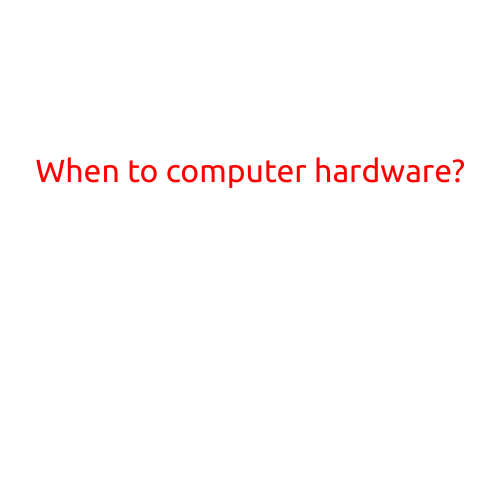
When to Upgrade Your Computer Hardware?
As a computer user, you may have noticed that your machine is no longer performing as smoothly and efficiently as it used to. This could be due to various reasons, including outdated hardware, software conflicts, or even physical wear and tear. In this article, we’ll explore the signs that indicate it’s time to upgrade your computer hardware and provide some valuable tips to help you make an informed decision.
1. Your Computer is Slow
If your computer takes an eternity to start up, launch applications, or complete tasks, it’s a clear sign that it’s due for an upgrade. Outdated hardware, such as a slow hard drive or limited RAM, can cause your computer to slow down. In this case, upgrading to a faster hard drive, such as an SSD (solid-state drive), or adding more RAM can make a significant difference in your computer’s performance.
2. Your Computer Consistently Crashes or Freezes
If your computer is crashing or freezing frequently, it’s likely due to outdated or malfunctioning hardware. This could be a sign that your computer’s motherboard, RAM, or graphics card needs to be replaced. In this case, upgrading your computer’s core components can help resolve the issue and prevent further crashes.
3. Your Computer’s Warranty Has Expired
If your computer’s warranty has expired, it may be more cost-effective to upgrade your hardware rather than repairing or replacing it. Many computer manufacturers offer extended warranty options, so be sure to check if your computer is still under warranty.
4. You’re Ready to Take Advantage of New Features
If you’re upgrading to a new operating system or using applications that require more powerful hardware, it may be necessary to upgrade your computer’s hardware. For example, if you’re switching to a 64-bit operating system, you’ll need more than 4GB of RAM.
5. You’re Experiencing Graphics Issues
If you’re experiencing graphics issues, such as blurry text or slow rendering times, it may be due to outdated graphics drivers or hardware. Upgrading your graphics card or installing the latest drivers can help resolve the issue.
What to Upgrade and When
If you’ve decided that it’s time to upgrade your computer hardware, here are some tips to help you make the right choices:
- Hard Drive: Upgrade to an SSD for faster loading times and improved overall performance.
- RAM: Add more RAM if your computer is using an outdated or limited amount.
- Graphics Card: Upgrade your graphics card if you’re experiencing graphics issues or want to take advantage of new features.
- CPU: Upgrade your CPU if you’re using an outdated or slow processor.
- Motherboard: Upgrade your motherboard if you’re experiencing hardware conflicts or want to add new components.
Conclusion
Upgrading your computer hardware can seem daunting, but it’s often a necessary step to keep your computer running smoothly and efficiently. By identifying the signs that indicate it’s time to upgrade and making informed decisions about what to upgrade and when, you can breathe new life into your computer and enjoy better performance and reliability.





